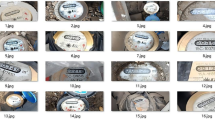Abstract
Automatically reading water meter is a classical OCR problem, typical method includes four major components: region of interests (ROIs) detection, skew correction of bounding boxes, single digital character segmentation, and digital classification. Disadvantage of the traditional method is that the pipeline is too complex and coupled to the accuracy of the final recognition result. Deep learning based object detection has achieved promising results on many computer vision tasks. As one of the representatives of the deep learning object detection framework, YOLOv3 perform detection task quickly and accurately. Inspired by this, we formulate the water meter reading problem as a detection problem, which is a true end-to-end solution. In order to attack the half-character problem of water meter, we proposed a heuristic rule to guarantee that there is only one bounding box in the vertical direction within a grid. Experimental results on our own built XMU-W-M dataset showed that the 0-error recognition rate reaches 96.67% and the 1-error recognition rate is up to 99.81%, which outperforms the traditional water meter recognition system in both time and precision. Both the code and dataset are available: https://github.com/sloan96/water-meter-recognition.
Supported by organization x.
Access this chapter
Tax calculation will be finalised at checkout
Purchases are for personal use only
Similar content being viewed by others
Notes
- 1.
Tzutalin. LabelImg. Git code (2015). https://github.com/tzutalin/labelImg.
- 2.
References
Redmon, J., Ali, F.: You only look once: unified, real-time object detection. IEEE (2015)
Redmon, J., Ali, F.: YOLO9000: better, faster, stronger. IEEE (2017)
Redmon, J., Ali, F.: YOLOv3: an incremental improvement. IEEE (2018)
LeCun, Y., Bottou, L., Bengio, Y., Haffner, P.: Gradient-based learning applied to document recognition. IEEE (1998)
Matan, O., Burges, C.J.C., LeCun, Y., Denker, J.S.: Multi-digit recognition using a space displacement neural network. In: NIPS (1991)
Guo, Q., Lei, J., Tu, D., Li, G.: Reading numbers in natural scene images with convolutional neural networks. In: Proceedings of the IEEE Conference on Computer Vision and Pattern Recognition (2014)
Wang, T.C., Liu, M.Y., Zhu, J.Y.: High-resolution image synthesis and semantic manipulation with conditional gans. In: Proceedings of the IEEE Conference on Computer Vision and Pattern Recognition (2018)
Johnson, J., Alahi, A., Fei-Fei, L.: Perceptual losses for real-time style transfer and super-resolution. In: European Conference on Computer Vision (2016)
Dalal, N., Triggs, B.: Histograms of oriented gradients for human detection. IEEE (2005)
Vapnik, V.N.: An overview of statistical learning theory. IEEE (1999)
Netzer, Y., et al.: Reading digits in natural images with unsupervised feature learning. In: NIPS (2011)
Goodfellow, I.J., Pouget-Abadie, J., Mirza, M.: Generative adversarial nets. In: NIPS (2014)
Jain, A.K.: Data clustering: 50 years beyond K-means. In: ECML/PKDD (2008)
Author information
Authors and Affiliations
Corresponding author
Editor information
Editors and Affiliations
Rights and permissions
Copyright information
© 2019 Springer Nature Switzerland AG
About this paper
Cite this paper
Liao, S., Zhou, P., Wang, L., Su, S. (2019). Reading Digital Numbers of Water Meter with Deep Learning Based Object Detector. In: Lin, Z., et al. Pattern Recognition and Computer Vision. PRCV 2019. Lecture Notes in Computer Science(), vol 11857. Springer, Cham. https://doi.org/10.1007/978-3-030-31654-9_4
Download citation
DOI: https://doi.org/10.1007/978-3-030-31654-9_4
Published:
Publisher Name: Springer, Cham
Print ISBN: 978-3-030-31653-2
Online ISBN: 978-3-030-31654-9
eBook Packages: Computer ScienceComputer Science (R0)




